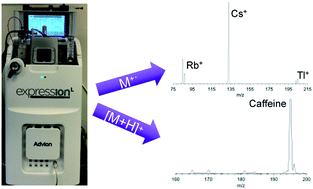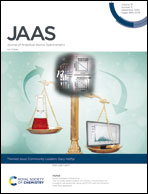Coupling the liquid sampling – atmospheric pressure glow discharge, a combined atomic and molecular (CAM) ionization source, to a reduced-format mass spectrometer for the analysis of diverse species†
Abstract
The LS-APGD microplasma has shown potential as a combined atomic and molecular (CAM) ionization source, though to this point it has been solely interfaced with large, laboratory-scale instruments. There are many instances wherein reduced-format, lower operating overhead, analyzers are appropriate. To this end, the LS-APGD has been coupled with an Advion ExpressionL Compact Mass Spectrometry (CMS) for the analysis of diverse samples. This instrument has been previously travel hardened in accordance to MIL-SPEC-810, demonstrating its suitability for in-field analysis. The coupling of the LS-APGD to this instrument expands its capability for diverse analyses, with early-stage figures of merit presented here. With this new coupling, a thorough optimization of both the instrument ion optics and the LS-APGD operating parameters was necessary as this platform does not have a direct method for collisional dissociation of potentially-deleterious molecular species. Under the optimized conditions, analytical response curves were constructed for Na, Rb, Cs, and Tl, demonstrating detection limits between 17.6–146 ng mL−1 (single ng, absolute). Furthermore, CAM sampling capabilities can be realized upon changing from a 2% HNO3 to a 70 : 30 MeOH : H2O solvent system, providing molecular-level chemical information readily obtained from atomic ionization sources such as the inductively coupled plasma (ICP-MS). Here detection limits between 1–32 nM (single pg, absolute) were obtained for caffeine, acetaminophen, Δ9-tetrahydrocannabidiol, sulfadimethoxine, terfenadine, and reserpine. The unique features of the CAM ionization source on this flexible MS platform hold promise for many operation environments.

- This article is part of the themed collection: Community Leaders: Gary Hieftje


 Please wait while we load your content...
Please wait while we load your content...